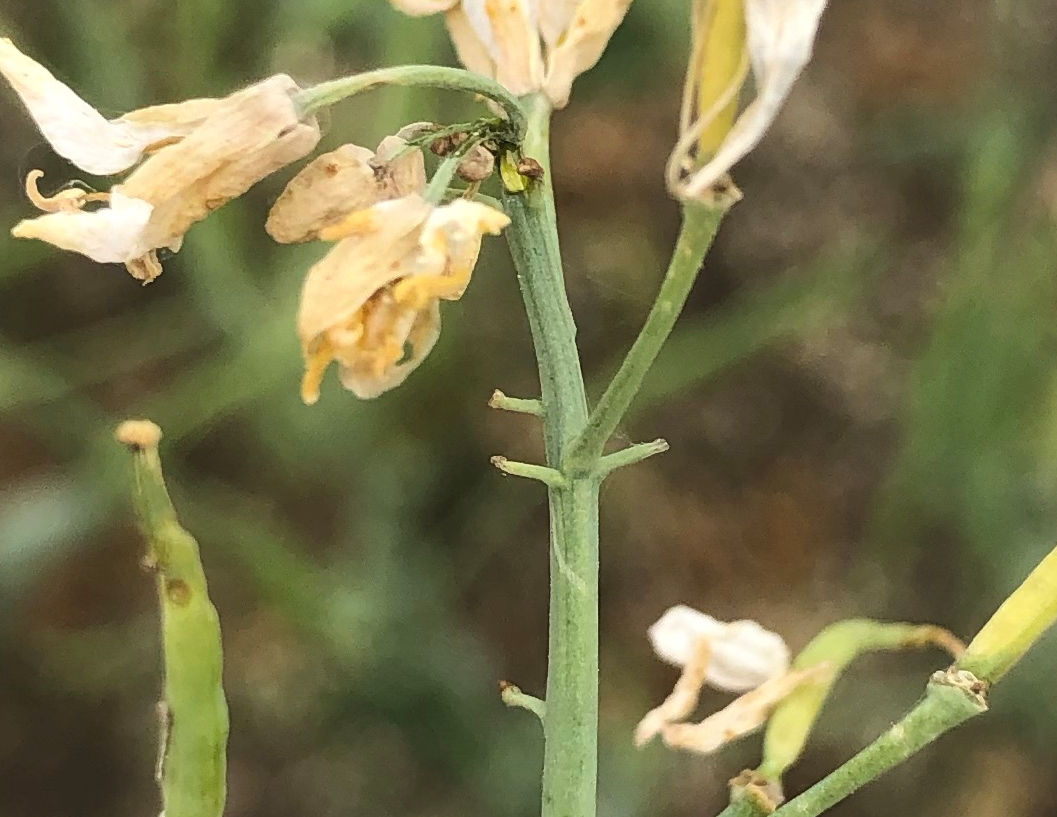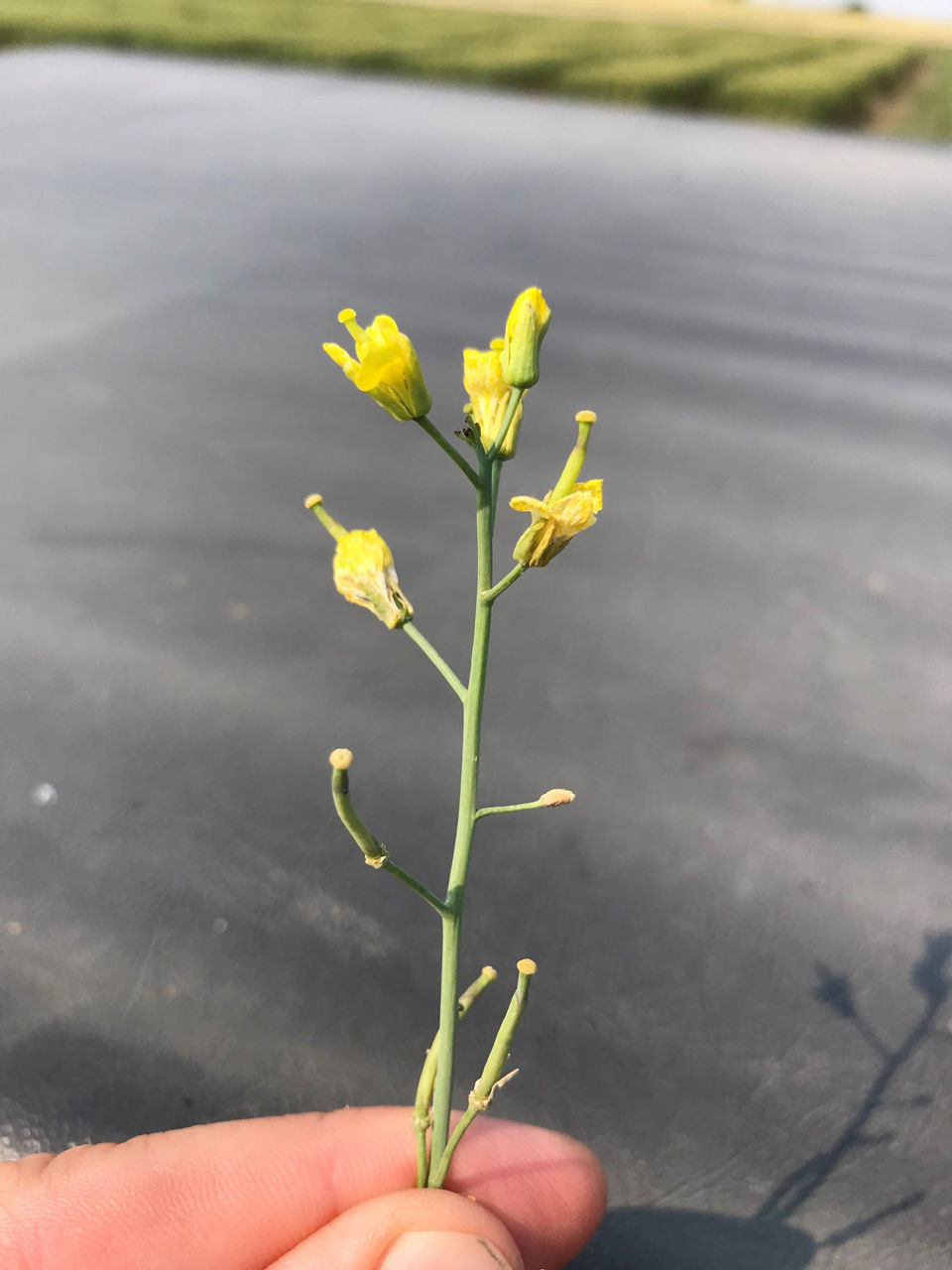Heat Stress and Blank Pods in Canola
February 1, 2024
Should I scout for blank pods in my canola crop?
It is a good idea to examine flowers for heat blast while scouting canola fields for diseases, insects, and weeds. Flowers that open with shortened stamens that do not extend beyond the petals are a sign of heat damage. Lighter colored petals can indicate that a flower is drying and therefore will not produce a full pod (Figure 1). Take note of fields with symptoms of heat stress at the beginning of flowering. Pod development may be impacted in these fields, but flowering may recover enough to allow pod development higher on the plant.


It is important to note that typically 45 to 60 percent of flowers on a canola plant do not develop into productive pods.1 Canola overproduces flowers at the bottom of the plant from the beginning of the bloom period and continues to produce more flowers up the stem. Often, the topmost flowers are not needed, young pods fail to enlarge, and drop from the plant.
How do high temperatures affect flowering and pod formation in canola?
Canola is a cool-season plant, and temperatures of 28 to 30 °C (82 to 86 °F) during the day and 16 °C (61 °F) at night are considered hot enough to cause heat stress from bud to mid-flowering stages.2 High temperatures for even a few days can cause imbalanced plant hormones, resulting in a breakdown between the stigma (female part of the flower) and any pollen grains (male) that have fallen on it. Pollen tubes are then unable to develop and pollen grains are unable to move from the stigma surface to the unfertilized egg to develop into seeds, thus pod formation and seed set will not occur.3
Heat injury to a flower’s reproductive structures is influenced by heat-related changes in gene expression. Genes affecting cell wall organization and cellular transport are downregulated during heat events. Pollen survival can go from 90 to 25 percent with four hours of high temperatures, and successful pollen tube germination drops from 62 percent to 10.4
Pod formation is affected by severe plant stress, which can also be caused by extremely low temperatures or drought during flowering. Frost damage to canola at flowering appears as aborted flowers or poorly filled pods.5 Drought during flowering appears as aborted flowers and reduced pod set.6
What if conditions improve and temperatures cool down?
Plants can recover with lower temperatures and adequate moisture. However, depending on the growth stage, it could be a week before a canola plant’s hormones rebalance and pod formation returns. Ideal conditions for flowering would include good moisture and temperatures between 13 and 22 °C (55 and 71 °F).1 Flowering typically lasts two to three weeks under these conditions.
A yield reduction may not occur if conditions improve by early- to mid-flower stage.2 Ideal conditions occurring and declining over the three-week flowering period can result in plants aborting and preserving flowers off and on, which will result in barren areas along the stem (Figure 3).

What if hot temperatures continue and rains are variable?
There is an increased sensitivity to heat stress at early flowering compared to pod fill. Heat stress during pod fill and the resulting hormone imbalance can cause formed seeds to germinate in the pod.
Drought stress exacerbates heat stress, with heat damage occurring at lower temperatures during moisture stress. If drought stress continues, later developing flowers are dropped from the top of the main raceme and branches. By doing this, plants can put their remaining energy into preserving the lower pods.
Cool nights help canola plants recover from hot daytime temperatures, while warm nights (16 °C, 61 °F) cause more flowers to abort.2 Waterlogged soils in conjunction with high temperatures can also reduce yield potential.1 Rains that are timely and moderate help fill seeds but won’t increase the number of seeds after the bloom stage.7
Are there any remedies farmers can use to help preserve canola yield potential during heat stress?
Not at the current time. Timely rains and cooler temperatures, even cooler evenings, are needed to help the crop develop. Nutrient applications that include boron and sulfur have been tested as possible heat stress treatments, as deficiencies of these nutrients can lead to empty pods. However, a positive yield response from these nutrient applications has not consistently been proven during heat stress at flowering.3
Canola varieties are being evaluated for their tolerance to heat stress. Because variety differences can affect this year’s crop, it is worth noting which canola product held up this summer and had the best yield at harvest. Soil differences will also be a factor, as water-holding capacity often goes together with heat- and drought-stress survival.
Consider selecting multiple canola varieties with different maturities and managing planting dates accordingly. Planting the early maturing canola variety first and the later maturing variety last can help spread out flowering timing. This can help reduce risk of all canola on the farm experiencing a heat wave during mid-flower.
Can drought-stressed canola be used or marketed for other uses?
Canola is a palatable feed for livestock. Canola has nutrient compositions close to alfalfa, with crude protein of 12 to 16 percent and digestible nutrients of 55 to 60 percent.8 If used for forage, higher crude protein and energy levels are usually found when it is cut during the early podded stage. However, it is important to know the sulfur and nitrate levels of any drought-stressed canola used for forage. Plants should be dried to 16 to 18 percent moisture if baled. Moistures of about 65 percent are recommended for ensiled canola.8
Sources:
1 Canola Council of Canada. 2006. Missing pods or blanks on the main stem! What could be the cause? https://canola.okstate.edu/cropproduction/missingblankpods/missingpodsorblankstemswhatcouldbethecause.pdf
2 Canola Council of Canada. 2018. Hot days and 6 other reasons for missing pods. CanolaWatch. https://www.canolacouncil.org/canola-watch/2018/07/05/hot-days-and-6-other-reasons-for-missing-pods/
3[RealAgriculture]. 2021. Canola school: The science of heat blast and what you can do about it [Video]. YouTube. https://www.youtube.com/watch?v=V5Ox9WIO_Ic
4 Hannink, N. 2021. Climate, canola, and coping with changing conditions. University of Melbourne. https://phys.org/news/2021-02-climate-canola-coping-conditions.html.
5 Government of Western Australia. 2017. Diagnosing frost damage in canola. Department of Primary Industries and Regional Development. https://agric.wa.gov.au/n/3169
6 Government of Western Australia. 2015. Diagnosing spring drought in canola. Department of Primary Industries and Regional Development. https://agric.wa.gov.au/n/3171
7 Raine, M. 2001. Heat blasts canola yields. The Western Producer. https://www.producer.com/news/heat-blasts-canola-yields/
8 Meehan, M., Carlson, Z., and Block, J. 2021. Drought-stressed canola possible forage for livestock. North Dakota State University. Extension and Ag Research News.
2014_171101
Seed Brands & Traits
Crop Protection
Disclaimer
Always read and follow pesticide label directions, insect resistance management requirements (where applicable), and grain marketing and all other stewardship practices.
©2024 Bayer Group. All rights reserved.